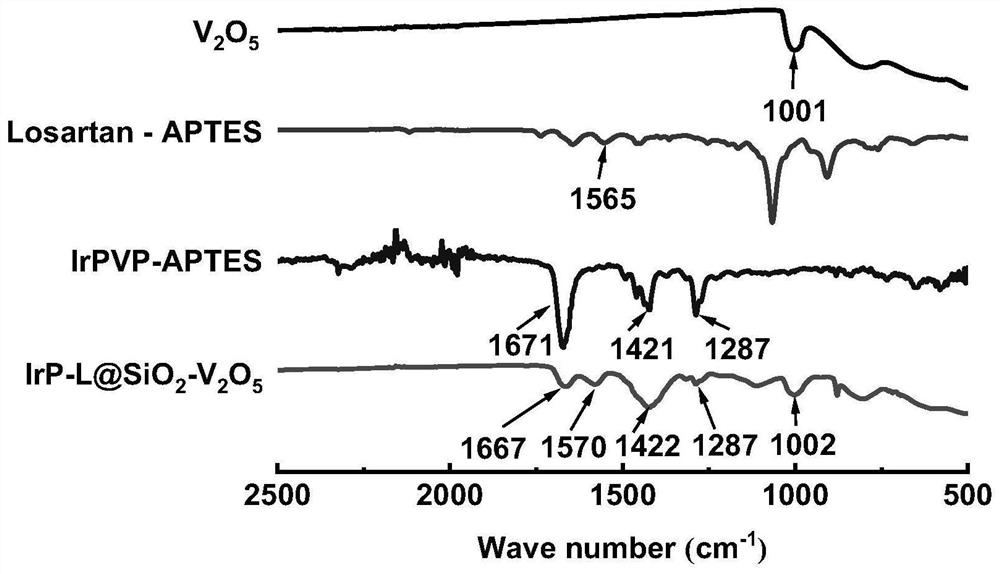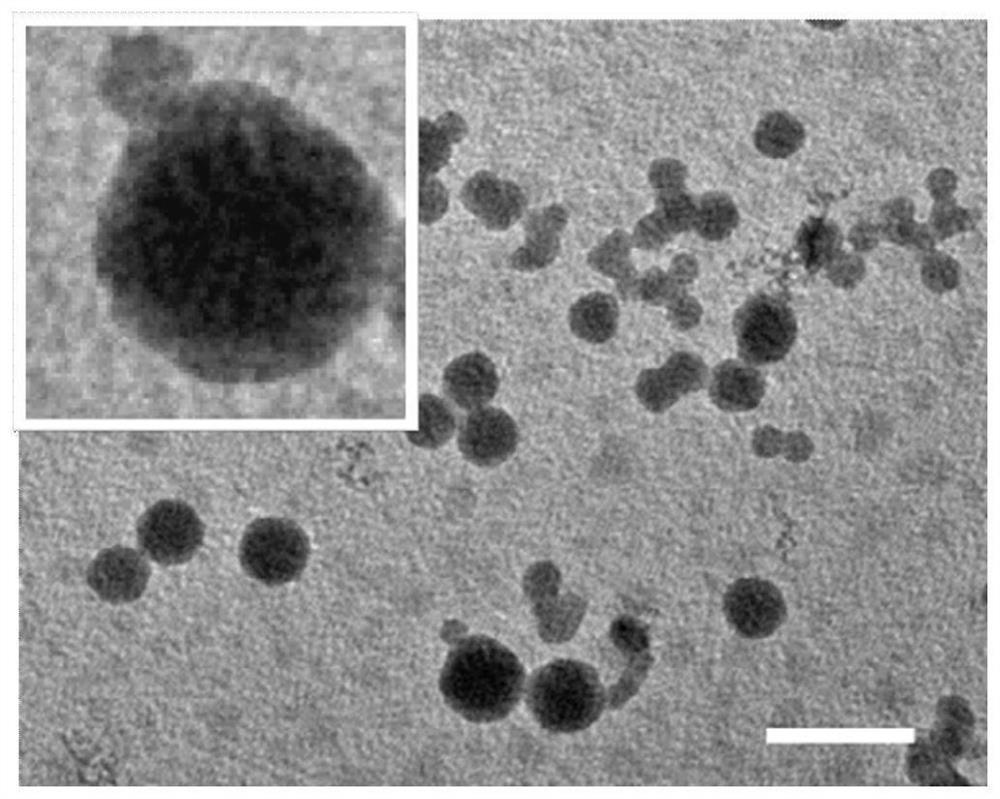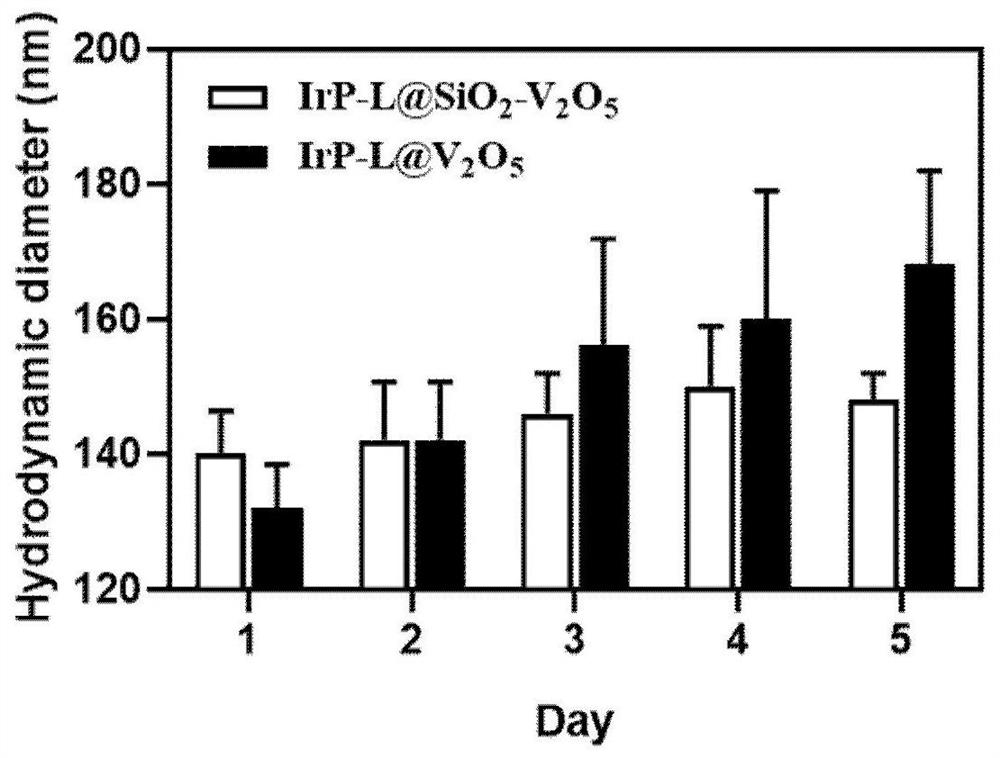Composite nano material taking vanadium pentoxide as core and application
A vanadium pentoxide and nanoparticle technology, applied in the field of biomedicine, can solve problems such as limited oxygen supply capacity, differences in drug circulation, and excessive drug metabolism, and achieve the effects of improving hypoxia, overcoming self-limitation, and improving tumor perfusion
- Summary
- Abstract
- Description
- Claims
- Application Information
AI Technical Summary
Problems solved by technology
Method used
Image
Examples
Embodiment 1
[0047] Example 1: Preparation of silica-vanadium pentoxide nanoparticles coupled with losartan and iridium complex.
[0048] a. Weigh 1.2g of vanadium pentoxide and 2.5g of oxalic acid dihydrate into 40mL of water and heat it to 60°C for 1 hour, then add it together with 20mL of isopropanol and 10mL of n-butanol into the reaction kettle, and react at 200°C for 12h Afterwards, it was taken out and calcined at 300 degrees for 2 hours to obtain vanadium pentoxide nanoparticles.
[0049] b. APTES (221 mg, 1 mmol) and succinic anhydride (100 mg, 1 mmol) were dissolved in 20 ml dry DCM. After stirring overnight at room temperature, the solvent was evaporated under reduced pressure using a rotary evaporator to obtain carboxysiloxane. HNMR (400MHz, CDCl3): δ=3.86(t,6H),3.42(t,2H),2.60(t,2H),2.50(t,2H),1.51(m,2H),1.21(t,9H) ,0.56(t,3H).
[0050] c. APTES (220 mg, 1 mmol) and triethylamine (200 mg, 2 mmol) were dissolved in 20 mL of anhydrous DCM and stirred in an ice bath for 10 min...
Embodiment 2
[0054] Example 2 Preparation of vanadium pentoxide nanoparticles coated with losartan and iridium complexes
[0055] Referring to steps a-e of Example 1, the corresponding products were prepared in sequence. 200mg iridium complex siloxane and 10mg V 2 o 5 Nanoparticles were added to 50ml anhydrous toluene and sonicated for 0.5h. The solution was heated to 120°C and refluxed for 24 hours. The obtained solid was washed 5 times with toluene, and then dried in vacuum to obtain vanadium pentoxide nanoparticles coated with iridium complexes (IrP@V 2 o 5 ). 65mg IrP@V 2 o 5 Vanadium pentoxide nanoparticles co-coated with iridium complexes and losartan (IrP-L@V 2 o 5 ).
Embodiment 3
[0057] 1mg mL -1 IrP-L@V 2 o 5 and IrP-L@SiO 2 -V 2 o 5 The nanoparticles were respectively placed in 10% fetal bovine serum solution, and then the change of the hydrated particle size was measured by dynamic light scattering. like image 3 As shown, IrP-L@SiO 2 -V 2 o 5 The nanoparticles have better stability and are not easy to aggregate. As time increases, the particle size does not increase significantly. With the IrP-L@SiO of Example 1 2 -V 2 o 5 Compared with, the obtained vanadium pentoxide nanoparticles IrP-L@V of embodiment 2 2 o 5 The stability of the particle is poor, and as time increases, it is easy to aggregate, and the particle size gradually increases, which is easy to cause safety problems such as blood vessel blockage in the body.
PUM
 Login to View More
Login to View More Abstract
Description
Claims
Application Information
 Login to View More
Login to View More - R&D
- Intellectual Property
- Life Sciences
- Materials
- Tech Scout
- Unparalleled Data Quality
- Higher Quality Content
- 60% Fewer Hallucinations
Browse by: Latest US Patents, China's latest patents, Technical Efficacy Thesaurus, Application Domain, Technology Topic, Popular Technical Reports.
© 2025 PatSnap. All rights reserved.Legal|Privacy policy|Modern Slavery Act Transparency Statement|Sitemap|About US| Contact US: help@patsnap.com



